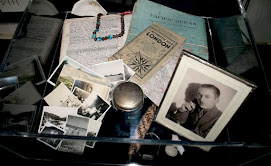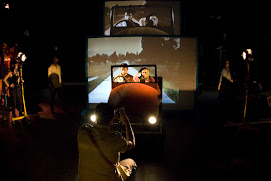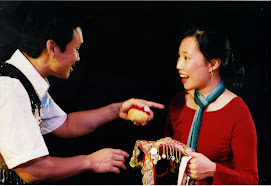30 January 2009
australianplays.org
26 January 2009
From Taishō Chick

Here's that excerpt from Taishō Chick:
…
In times of change I open the dictionary.
Not literally, but to open a crease in the language and reveal what we couldn’t say yesterday
in public
we drummed out syncopated rhythms with chopsticks. Drew cartoons with cold coffee on table tops.
Painting was my way of walking into the heart of the world without anybody knowing I was shy.
A taxi over the bridge, a little avant-garde introspection in the shade of the willow trees, and rice riots—that’s rice, R-I-C-E, not race. The poor were being bossed around by the high cost of rice.
For the not-so-poor
It was the age of silk stockings, foxtrots and all that jazz.
Of department stores and opinions—remember, long before the iPod brought music to our ears, the I-novel brought us first-person narratives.
I look for myself
and find
a café waitress lining up her future. Irie Takako starting her own film production company. Journalists reporting the latest from Paris or Shanghai. Young men in suits tailored British style.
And the key to all this activity?
The city.
The adventures and affairs of the metropolis …
18 January 2009
Guerrilla Gardens

Pyrmont is an inner city suburb of apartments and recent redevelopment a hop, skip and jump from the Sydney CBD. Many of us live in units with garden areas shared by the whole building. Gardens designed and laid out when our blocks of flats were constructed, and thereafter maintained by contractors. So it does more than jazz up my walks around the neighbourhood to discover that local residents have dug up verges and sections of public space to plant rosemary and rocket. Or apartment dwellers reclaimed their manicured borders and sown lettuces between the body corporate's shrubs.
Didn't realise it when I began taking an interest in the Pyrmont plots, but guerrilla gardening is a growing urban phenomenon. According to Wikipedia it’s ‘political gardening, a form of non-violent direct action, primarily practiced by environmentalists.’ But from a quick online trawl the term seems more of an umbrella one to describe different kinds of community gardening, with differing mixes of social and horticultural ambition. (Guerrilla Gardeners is also the title of a forthcoming Channel 10 program. Haven’t seen it, but here's how I’d guess it goes: instead of feral kids, wayward pets or ailing back yards, a photogenic, predominantly blonde team makeover scrappy public places. Lifestyle activism or protest lite for a primetime audience. But hey, maybe for once those TV executives will surprise us … ?)

Anyway, the guerrilla gardeners of Pyrmont have sparked my curiosity, and I'm going to keep my eye on their plots—who knows, I might even join them for a spot of midnight night spade work? In the meantime, check out GuerrillaGardening.org
10 January 2009
The Hannah First Collection, 1919—1949

A performance essay with PowerPoint images and a display case of ‘memorabilia’ we presented The Hannah First Collection, 1919—1949 as part of the Zendai Museum of Modern Art's Intrude: Art & Life 366 project in Shanghai in November 2008.
The work charts my quest to discover and reconstruct the life and journeys of the early-to-mid 20th century anthropologist and traveller, Hannah First. Drawing on the traditions of the old-fashioned ‘family slide evening’ and the ‘illustrated lecture’ as well as the blog and social networking sites, I follow Hannah from Amsterdam to Oxford. Check out her trips to Ceylon and Singapore, and her fieldwork in Central Europe, Palestine and the palm-fringed Tikabar Islands of the Western Pacific. To do this, I use not only photographs, notebooks and artefacts, but also my own life experiences—finding considerable symmetry between myself and this intriguing and improbable anthropologist …

In the last part of the performance, following an important revelation about Hannah First, I move on to explore our preoccupation with nostalgia. Why has nostalgia become our preferred mode of reckoning not only with the present, but with a strangely depoliticised past?
Conceived, written & performed by Noëlle JanaczewskaDirected by Sally Sussman
In Shanghai we presented a bilingual version of The Hannah First Collection, 1919—1949, in English and Chinese.
Chinese translation: Wu Chenyun
Chinese performer: Yao Mingde

This project was supported by the Australia-China Council.
01 January 2009
Time To Refocus
Well, that was the theory. The practice was that last year I posted a mere 4 times. There are a lot of reasons I can give for this: lack of time, pressure of deadlines, the imperatives of paid work (doing it and looking for more), other commitments, the ups and downs of the freelance life, perfectionist tendencies … the usual suspects. To which I’d also add: the wrong direction—for some reason I’ve ended up focusing too much on arts issues and policies—and the death of my father.
My father died in September, and I’m still grieving. He taught me to value the life of the mind, to love questions more than answers, and the quest more than the goal. He put the wanderlust in my soul and didn’t complain when it took me to the other side of the world. And he had a talent for spinning stories out of the mundane, and infusing even a simple stroll with a sense of mystery. I remember one night when I was still at primary school, Dad woke us up, myself and my brother, to go for a walk to see a badger set and listen to the call of owls. The badgers proved elusive, but the owls were in fine voice. Reflecting on that incident now, I realise it was probably not terribly late at all, but as a 7 or 8-year-old, it felt as if I were being woken in the middle of the night to go on a magnificent adventure.

Me & Dad
In the days immediately after my father’s death I wrote like crazy. On the long flight from Sydney to London I used my laptop, and when its battery ran out I continued writing with pen and paper. After the funeral however, the words ran out and my mind fixed on questions of time—time being finite, time running out, how I wanted to spend my time ...
3 months later, this is where I’m up to:
- I might have a lot of opinions, but an opinion column is not what I want to spend my time writing. (There are others more engaged with and better placed to critique arts issues than I am.)
- I don’t need another unpaid writing gig.
- If time spent blogging is time I could be writing other things, then why not use the blog as more of a writer’s notebook?
So I’m going to use this blog somewhat differently. I’m relaunching it in a looser, more flexible vein. It will be more of a notebook, there for process, a place of personal reflection, a place to jot down snippets and random ideas or start new trains of thought. I may post excerpts, report news and comment on work that I have seen, heard or read—and I may not. I will post as often or as infrequently as I wish and give myself the latitude to look outside theatre and write about whatever sparks my interest.
For example, in March 2008 I saw an exhibition of photographs at the National Maritime Museum: Steel Beach—Shipbreaking in Bangladesh. I’ve long been fascinated by certain kinds of documentary photography—Sebastião Selgado, et al. And these photos of a huge, muddy ships’ graveyard in the Bay of Bengal by Andrew Bell completely captured my imagination. I wanted to write about them, not a review, but a more personal, poetic kind of response to his images. I didn’t—for a whole bunch of reasons, not least because: where would I place something like that? So I’m going to use the new, realigned outlier-nj for things like that.
Another ongoing interest is architecture and urban geography—reignited in November when I went to Shanghai to present The Hannah First Collection, 1919—1949 as part of the Zendai Museum of Modern Art’s Intrude: Art & Life 366 project. Zendai MoMA is in the Pudong district of Shanghai, so that was where we were staying. In his book Concrete Reveries, Mark Kingwell describes Pudong as an area of ‘shopaholic emptiness’. True—to a point. But my stay there got me thinking, and now researching and writing, about skyscrapers and the migration of the early 20th century American skyline to other parts of the world. Not sure yet what form this piece will take—will keep you posted.

So what else for 2009? As well as projects with 7-ON, I’m concentrating on the Performance Essays. I hope to find a venue/context to present The Hannah First Collection, 1919—1949 in Australia, and I’m writing Bounce, a new performance essay about the history of rubber and how I wanted to be an explorer when I grew up. About my recent trip to the Amazon and my father’s journey through Parkinson’s Disease to the great unknown of death. Oh and I’m also branching out with projects across non-fiction, fiction, spoken word and poetry.
Happy 2009!
+Photo+Leah+McGirr+3.jpg)



